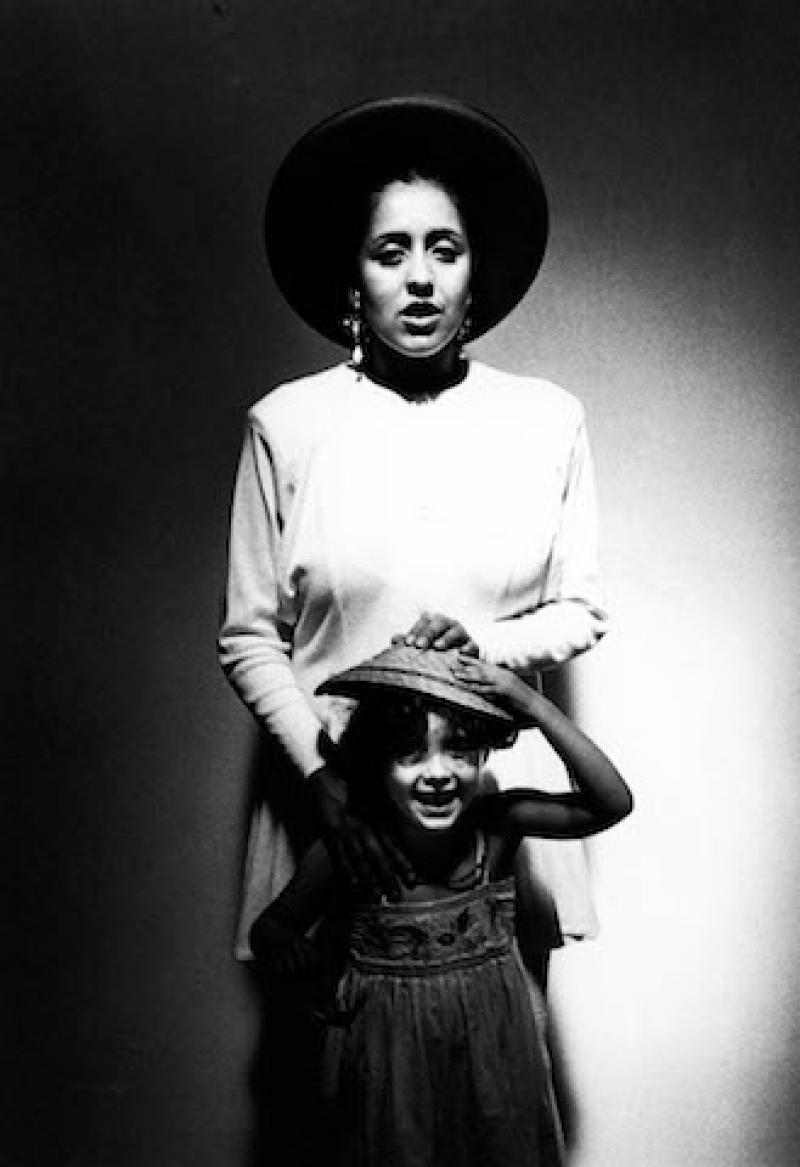Poly Styrene: I Am a Cliche review - memorialising her mother | reviews, news & interviews
Poly Styrene: I Am a Cliche review - memorialising her mother
Poly Styrene: I Am a Cliche review - memorialising her mother
Documentary portrait of a punk legend who struggled with fame

There was always something a little diffident about teenage Marion Elliott-Said, who created her on-stage persona Poly Styrene after putting together her band X-Ray Spex from a small ad in the back pages of the NME in 1977.
Born in ‘57 and raised on a council estate in South London by her English mother, she didn’t see much of her Somalian father and as a mixed-race child in that era, battled with not quite fitting in among either the black or white families around her. Leaving school at fifteen to go travelling around England, she tried to make a career in fashion and then recorded a lovers rock song before having an epiphany at a Sex Pistols gig in Hastings. Fronting X-Ray Spex, Poly Styrene went on to have hits with ‘Oh Bondage up Yours’ and ‘Germ Free Adolescents’ and played New York before leaving the band after three short years.
 Celeste Bell, the singer’s daughter (pictured right), has co-directed I Am a Cliché with Paul Sng and had excellent access to Poly Styrene’s archive of diaries, song lyrics, newspaper cuttings and art works. Intercut with amateur footage, TV interviews and film of the band on stage and on the road (frustratingly unattributed or dated), Bell tells the story of how her mother found the pressure of being mobbed by fans and patronised by the press too much to bear.
Celeste Bell, the singer’s daughter (pictured right), has co-directed I Am a Cliché with Paul Sng and had excellent access to Poly Styrene’s archive of diaries, song lyrics, newspaper cuttings and art works. Intercut with amateur footage, TV interviews and film of the band on stage and on the road (frustratingly unattributed or dated), Bell tells the story of how her mother found the pressure of being mobbed by fans and patronised by the press too much to bear.
In a 1979 Arena (available on You Tube and extracted here), Poly Styrene (above) was already talking about her unease with her punk persona: “I liked playing the character. I thought it was fun, but now I’m not into it, I’m just Marion Elliott”. An attempt to reinvent herself as a more melodic singer-songwriter was met with critical hostility and she was dropped by her record label.
A brief marriage resulted in Celeste, but Marion experienced some kind of breakdown, began seeing visions and couldn’t look after her child. She ended up sectioned, misdiagnosed with schizophrenia before finding a way to live with bipolar disorder. There are shades of the Britney Spears and Amy Winehouse stories here; talented, vulnerable young women who craved attention on stage but found the music industries access to drugs – and fame itself – just too much to bear.
Marion Elliott reinvented herself again as a devotee of Krishna and spent five years living in the Hertfordshire temple funded by George Harrison, Bhaktivedenta Manor. Leaving the Hare Krishnas after another breakdown, she eventually lived independently and was reconciled with her daughter. She made a comeback with X-Ray Spex in 2008, singing on stage at the Roundhouse with Celeste but was diagnosed with terminal breast cancer.
I Am a Cliché features interviews not only with family members but also with many of the key players of that era – filmmaker-DJ Don Letts, band members including Lora Logic, admirers like singers Pauline Black and Neneh Cherry and journalists Jonathan Ross, Lucy O’Brien and Vivien Goldman. Johnny Rotten, who once locked Poly Styrene in a cupboard for an hour, doesn’t come out of their accounts too well. The documentary captures young women artists' struggles in punk culture, which may have been anti-Establishment but was still riddled with testosterone.
None of these witnesses appear on screen, their audio interviews are dropped in over archive footage and the audience doesn’t get any sense of how they appear today. To me, this is a somewhat unsatisfying way to direct a documentary, even if its makers hope that not putting their interviewees on screen makes for something more "filmic" than a traditional talking-heads arts TV documentary. Unfortunately, the lack of onscreen interviewees also allows for a little too much screen time to be spent on nicely filmed sequences of Celeste Bell herself talking through her memories of her difficult childhood and revisiting locations that had been important to her mother. Despite these stylistic reservations, this is still a fascinating documentary about an extraordinary woman.
rating
Share this article
The future of Arts Journalism
You can stop theartsdesk.com closing!
We urgently need financing to survive. Our fundraising drive has thus far raised £49,000 but we need to reach £100,000 or we will be forced to close. Please contribute here: https://gofund.me/c3f6033d
And if you can forward this information to anyone who might assist, we’d be grateful.

Subscribe to theartsdesk.com
Thank you for continuing to read our work on theartsdesk.com. For unlimited access to every article in its entirety, including our archive of more than 15,000 pieces, we're asking for £5 per month or £40 per year. We feel it's a very good deal, and hope you do too.
To take a subscription now simply click here.
And if you're looking for that extra gift for a friend or family member, why not treat them to a theartsdesk.com gift subscription?
more Film
 Islands review - sunshine noir serves an ace
Sam Riley is the holiday resort tennis pro in over his head
Islands review - sunshine noir serves an ace
Sam Riley is the holiday resort tennis pro in over his head
 theartsdesk Q&A: actor Sam Riley on playing a washed-up loner in the thriller 'Islands'
The actor discusses his love of self-destructive characters and the problem with fame
theartsdesk Q&A: actor Sam Riley on playing a washed-up loner in the thriller 'Islands'
The actor discusses his love of self-destructive characters and the problem with fame
 Honey Don’t! review - film noir in the bright sun
A Coen brother with a blood-simple gumshoe caper
Honey Don’t! review - film noir in the bright sun
A Coen brother with a blood-simple gumshoe caper
 The Courageous review - Ophélia Kolb excels as a single mother on the edge
Jasmin Gordon's directorial debut features strong performances but leaves too much unexplained
The Courageous review - Ophélia Kolb excels as a single mother on the edge
Jasmin Gordon's directorial debut features strong performances but leaves too much unexplained
 Blu-ray: The Graduate
Post #MeToo, can Mike Nichols' second feature still lay claim to Classic Film status?
Blu-ray: The Graduate
Post #MeToo, can Mike Nichols' second feature still lay claim to Classic Film status?
 Little Trouble Girls review - masterful debut breathes new life into a girl's sexual awakening
Urska Dukic's study of a confused Catholic teenager is exquisitely realised
Little Trouble Girls review - masterful debut breathes new life into a girl's sexual awakening
Urska Dukic's study of a confused Catholic teenager is exquisitely realised
 Young Mothers review - the Dardennes explore teenage motherhood in compelling drama
Life after birth: five young mothers in Liège struggle to provide for their babies
Young Mothers review - the Dardennes explore teenage motherhood in compelling drama
Life after birth: five young mothers in Liège struggle to provide for their babies
 Blu-ray: Finis Terrae
Bleak but compelling semi-documentary, filmed on location in Brittany
Blu-ray: Finis Terrae
Bleak but compelling semi-documentary, filmed on location in Brittany
 Oslo Stories Trilogy: Sex review - sexual identity slips, hurts and heals
A quietly visionary series concludes with two chimney sweeps' awkward sexual liberation
Oslo Stories Trilogy: Sex review - sexual identity slips, hurts and heals
A quietly visionary series concludes with two chimney sweeps' awkward sexual liberation
 Sorry, Baby review - the healing power of friendship in the aftermath of sexual assault
Eva Victor writes, directs and stars in their endearing debut feature
Sorry, Baby review - the healing power of friendship in the aftermath of sexual assault
Eva Victor writes, directs and stars in their endearing debut feature
 Blu-ray: Who Wants to Kill Jessie?
Fast-paced and visually inventive Czech comedy
Blu-ray: Who Wants to Kill Jessie?
Fast-paced and visually inventive Czech comedy
 Oslo Stories Trilogy: Love review - freed love
Gay cruising offers straight female lessons in a heady ode to urban connection
Oslo Stories Trilogy: Love review - freed love
Gay cruising offers straight female lessons in a heady ode to urban connection

Add comment